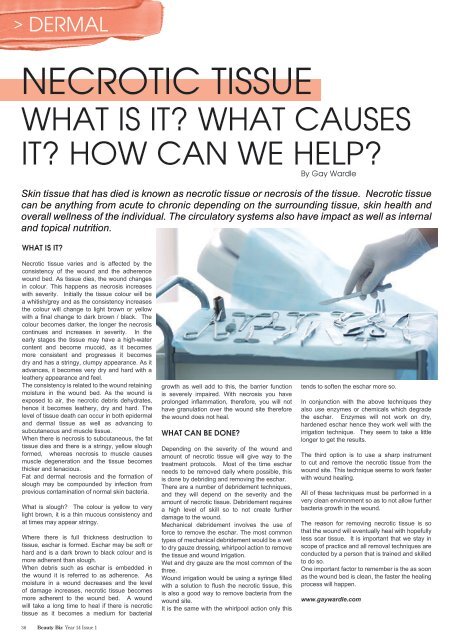Beauty Biz
You also want an ePaper? Increase the reach of your titles
YUMPU automatically turns print PDFs into web optimized ePapers that Google loves.
DERMAL<br />
NECROTIC TISSUE<br />
WHAT IS IT? WHAT CAUSES<br />
IT? HOW CAN WE HELP?<br />
WHAT IS IT?<br />
By Gay Wardle<br />
Skin tissue that has died is known as necrotic tissue or necrosis of the tissue. Necrotic tissue<br />
can be anything from acute to chronic depending on the surrounding tissue, skin health and<br />
overall wellness of the individual. The circulatory systems also have impact as well as internal<br />
and topical nutrition.<br />
Necrotic tissue varies and is affected by the<br />
consistency of the wound and the adherence<br />
wound bed. As tissue dies, the wound changes<br />
in colour. This happens as necrosis increases<br />
with severity. Initially the tissue colour will be<br />
a whitish/grey and as the consistency increases<br />
the colour will change to light brown or yellow<br />
with a final change to dark brown / black. The<br />
colour becomes darker, the longer the necrosis<br />
continues and increases in severity. In the<br />
early stages the tissue may have a high-water<br />
content and become mucoid, as it becomes<br />
more consistent and progresses it becomes<br />
dry and has a stringy, clumpy appearance. As it<br />
advances, it becomes very dry and hard with a<br />
leathery appearance and feel.<br />
The consistency is related to the wound retaining<br />
moisture in the wound bed. As the wound is<br />
exposed to air, the necrotic debris dehydrates,<br />
hence it becomes leathery, dry and hard. The<br />
level of tissue death can occur in both epidermal<br />
and dermal tissue as well as advancing to<br />
subcutaneous and muscle tissue.<br />
When there is necrosis to subcutaneous, the fat<br />
tissue dies and there is a stringy, yellow slough<br />
formed, whereas necrosis to muscle causes<br />
muscle degeneration and the tissue becomes<br />
thicker and tenacious.<br />
Fat and dermal necrosis and the formation of<br />
slough may be compounded by infection from<br />
previous contamination of normal skin bacteria.<br />
What is slough? The colour is yellow to very<br />
light brown, it is a thin mucous consistency and<br />
at times may appear stringy.<br />
Where there is full thickness destruction to<br />
tissue, eschar is formed. Eschar may be soft or<br />
hard and is a dark brown to black colour and is<br />
more adherent than slough.<br />
When debris such as eschar is embedded in<br />
the wound it is referred to as adherence. As<br />
moisture in a wound decreases and the level<br />
of damage increases, necrotic tissue becomes<br />
more adherent to the wound bed. A wound<br />
will take a long time to heal if there is necrotic<br />
tissue as it becomes a medium for bacterial<br />
growth as well add to this, the barrier function<br />
is severely impaired. With necrosis you have<br />
prolonged inflammation, therefore, you will not<br />
have granulation over the wound site therefore<br />
the wound does not heal.<br />
WHAT CAN BE DONE?<br />
Depending on the severity of the wound and<br />
amount of necrotic tissue will give way to the<br />
treatment protocols. Most of the time eschar<br />
needs to be removed daily where possible, this<br />
is done by debriding and removing the eschar.<br />
There are a number of debridement techniques,<br />
and they will depend on the severity and the<br />
amount of necrotic tissue. Debridement requires<br />
a high level of skill so to not create further<br />
damage to the wound.<br />
Mechanical debridement involves the use of<br />
force to remove the eschar. The most common<br />
types of mechanical debridement would be a wet<br />
to dry gauze dressing, whirlpool action to remove<br />
the tissue and wound irrigation.<br />
Wet and dry gauze are the most common of the<br />
three.<br />
Wound irrigation would be using a syringe filled<br />
with a solution to flush the necrotic tissue, this<br />
is also a good way to remove bacteria from the<br />
wound site.<br />
It is the same with the whirlpool action only this<br />
tends to soften the eschar more so.<br />
In conjunction with the above techniques they<br />
also use enzymes or chemicals which degrade<br />
the eschar. Enzymes will not work on dry,<br />
hardened eschar hence they work well with the<br />
irrigation technique. They seem to take a little<br />
longer to get the results.<br />
The third option is to use a sharp instrument<br />
to cut and remove the necrotic tissue from the<br />
wound site. This technique seems to work faster<br />
with wound healing.<br />
All of these techniques must be performed in a<br />
very clean environment so as to not allow further<br />
bacteria growth in the wound.<br />
The reason for removing necrotic tissue is so<br />
that the wound will eventually heal with hopefully<br />
less scar tissue. It is important that we stay in<br />
scope of practice and all removal techniques are<br />
conducted by a person that is trained and skilled<br />
to do so.<br />
One important factor to remember is the as soon<br />
as the wound bed is clean, the faster the healing<br />
process will happen.<br />
www.gaywardle.com<br />
38 <strong>Beauty</strong> <strong>Biz</strong> Year 14 Issue 1

















